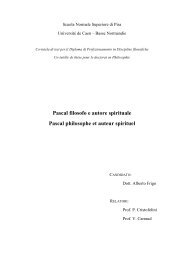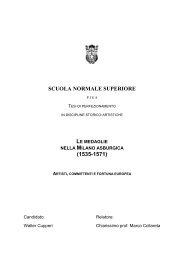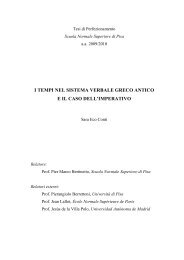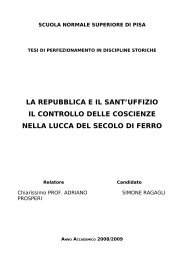CATULLUS 68 - Scuola Normale Superiore
CATULLUS 68 - Scuola Normale Superiore
CATULLUS 68 - Scuola Normale Superiore
Create successful ePaper yourself
Turn your PDF publications into a flip-book with our unique Google optimized e-Paper software.
1f. The poem starts with a reference to the letter of the addressee, just like a letter read out in a Plautine<br />
comedy: miles lenoni Ballioni epistulam / conscriptam mittit Polymachaeroplagides (Pl. Pseud. 998f.). Here<br />
Catullus uses the vocabulary of epistolography (quod, conscriptum, mittis, epistolium) to start his poem with<br />
a typical epistolary topos, that of the reference to a letter, whether one’s own or that of the addressee (see<br />
further on quod in line 1).<br />
1 The verse is echoed by Virgil at Aen. 5.700 at pater Aeneas casu concussus acerbo and possibly also<br />
by Ciris 313 tene etiam fortuna mihi crudelis ademit, which echoes line 20 below.<br />
Quod Not to be taken with hoc epistolium (pace Quinn), as a noun cannot be accompanied by a relative as<br />
well as a deictic pronoun: here and at lines 27 and 33 below quod is used on its own as if it were a sort of<br />
accusative of extent, meaning ‘as to the fact that’, ‘as for’ (see Kühner-Stegmann 2.269f. and Hofmann-<br />
Szantyr 573f.). The construction is found in Plautus and prose authors ranging from Cicero through Caesar to<br />
Tacitus (see OLD s.v. quod, 6a,) and occasionally in poetry outside comedy (thus at Lucr. 2.532 and 5.916,<br />
Verg. Aen. 11.177, Ov. Her. 17.261 and 17.43 but Kenney 1996 ad loc. interprets it as ‘though’, [Ov.] Am.<br />
3.5.41 and Priap. 6.1) but not in Tibullus, Propertius and Horace, nor in any other poem of Catullus’. It is<br />
used especially in letters, typically to pick up a subject that has been brought up by the correspondent in the<br />
letter one is responding to (thus Cic. Fam. 5.2.6 quod scribis non oportuisse Metellum, fratrem tuum, ob<br />
dictum a me oppugnari and Ov. Her. 17.261f. quod petis ut furtim praesentes ista loquamur, / scimus quid<br />
captes conloquiumque uoces). It is used most often within the letter as a formula of transition (‘Now as for<br />
…’), but it is also found as an introductory formula, as here (thus in Cic. Fam. 7.25, 7.32, 7.33, 14.12 and<br />
14.13, Caec. ap. Cic. Fam. 6.7 and Cael. ap. Cic. Fam. 8.1). Also paralleled in prose letters is the reference<br />
to the letter of the correspondent (Cic. Fam. 7.32.1 quod sine praenomine familiariter, ut debebas, ad me<br />
litteram misisti) and the way quod (whether or not meaning ‘As for’) is taken up by id gratum est in line 9<br />
(thus Cic. Fam. 12.28.2 quod societatem rei publicae conseruandae tibi mecum a patre acceptam renouas,<br />
gratum est … gratum etiam illud, quod mihi tuo nomine gratias agendas non putas: nec enim id inter nos<br />
facere debemus, 14.8 quod celeriter me fecisti de Caesaris litteris certiorem, fecisti mihi gratum, Cicero fils<br />
ap. Cic. 16.21.8 de mandatis quod tibi curae fuit est mihi gratum, Plin. Ep. 6.7.2 gratum est quod nos<br />
requiris, gratum quod his fomentis adquiescis and 3.5.1 pergratum est mihi quod tam diligenter libros<br />
auunculi mei lectitas and Fronto Epist. p. 60.17f. Naber = 55.6 van den Hout 2 utique illud ipsum, quod tanta<br />
ad me scripsisti, cum cras uenturus essem: id uero mihi longe fuit gratissimum; cfr. also Plin. Ep. 6.3.1 and<br />
Sulpicia ap. [Tib.] 4.10.1). The poem starts with the vocabulary and syntax proper to Roman letters.<br />
O writes Quo, which was found by Vossius in a MS (possibly in O itself: I know of no other MS that<br />
presents this reading, though here my notes only cover about half the recentiores) and Santenius reports that<br />
Nicolaus Heinsius found it worth preserving, probably in order to turn the first distich into a question (Quo<br />
… mittis epistolium?), which would have been answered in the following verses (naufragum ut …).<br />
However, Santenius noted that “quod firmari tamen videtur v. 9.”, that is, id in line 9 must pick up an<br />
epistolary Quod.<br />
94






